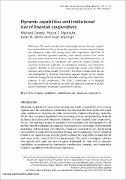| dc.contributor.author | Michael, Omeke | |
| dc.contributor.author | Pascal, T. Ngoboka | |
| dc.contributor.author | Isaac, N. Nkote | |
| dc.contributor.author | Isaac, Kayongo | |
| dc.date.accessioned | 2023-04-18T10:05:49Z | |
| dc.date.available | 2023-04-18T10:05:49Z | |
| dc.date.issued | 2020 | |
| dc.identifier.citation | Omeke, M., Ngoboka, P. T., Nkote, I. N., & Kayongo, I. (2020). Dynamic capabilities and institutional size of financial cooperatives. | en_US |
| dc.identifier.uri | <http://dx.doi.org/10.3362/1755-1986.19-00011> | |
| dc.identifier.uri | https://hdl.handle.net/20.500.12504/1318 | |
| dc.description.abstract | The study examines the relationship between dynamic capabilities and institutional size of financial cooperatives. A mixed research design was adopted to study 269 savings and credit cooperatives (SACCOs) in Uganda. Structural equation modelling and content analysis were carried out. The results indicate that dynamic capabilities and institutional size of financial cooperatives are significant and positively related. Further, the constructs of dynamic capability of coordination, learning, and competitive response contribute to the increase in membership, capital base, returns to members, and portfolio quality of SACCOs. The study concludes that the size and development of financial cooperatives depends heavily on the institutional and managerial capabilities for coordination, learning, and competitive responses to the environment. The study’s contribution is to highlight the complexity of the environment in which the financial cooperatives operate and the importance of dynamic capabilities to succeed. | en_US |
| dc.language.iso | en | en_US |
| dc.publisher | Practical Action Publishing | en_US |
| dc.subject | Dynamic capabilities, | en_US |
| dc.subject | Institutional size, | en_US |
| dc.subject | Financial cooperatives | en_US |
| dc.title | Dynamic capabilities and institutional size of financial cooperatives | en_US |
| dc.type | Article | en_US |

